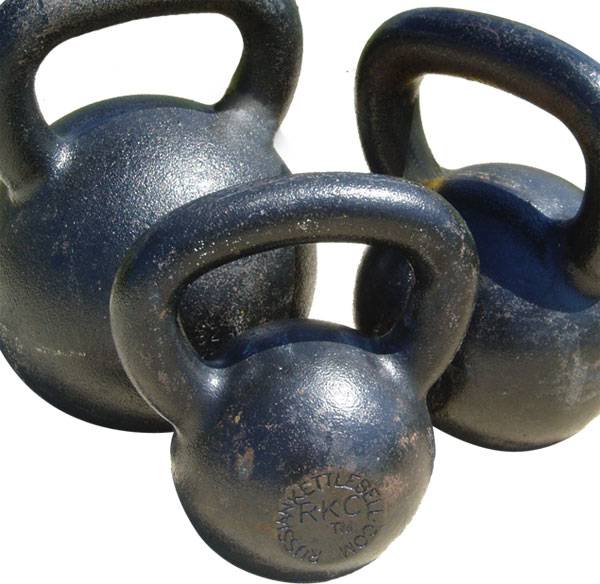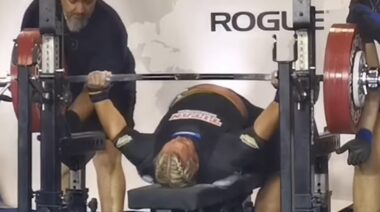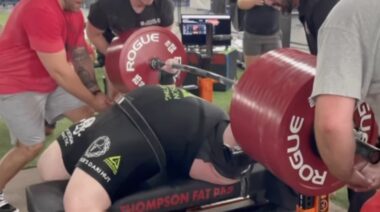Yesterday, I acquired two shiny new 22kg kettlebells. Today, to celebrate, I one-arm pressed one of them. Apparently, that’s pretty good for a 103lb chick, and I suddenly found myself getting messages as to how I trained my press.
Let me start by saying this: as a powerlifter, I have not in the last year or so been training overhead presses specifically, but rather using them as accessories to training my bench press. That having been said, I’ve picked up a lot of tips and tricks for increasing pressing strength along the way. What seems to work for everyone else never really works for me, so I’ll explain my own experience with each of these methods. If it didn’t work for me, it certainly does not invalidate the method – try it and see what it does for you.
Tool #1: Bench Press
Apparently, bench pressing helps overhead pressing. I say this because as I have been training my bench press, my overhead press has improved significantly. Without training overhead pressing strength specifically, I’ve been able to double press two 20kg bells. While I cannot say for sure my bench press should have all the credit for this, I can say it certainly has not impeded my progress. I’ve read numerous articles stating that bench press has no effect on overhead pressing. But like I said, what seems to work for everyone else does not seem to apply to me. So you might want to give it a shot, too.
Tool #2: Turkish Getups
This is one of those exercises that seem to work magic on the entire world, but doesn’t do much for me. There was a time when I TGUed like a madwoman, but I never saw gains in my press as a result. Despite that, the rest of the planet seems to glean tremendous benefit from the mighty Turkish getup. And why not? It works the shoulder from all angles and develops loaded stability and mobility. Definitely add heavy getups to your routine and see if they don’t add some poundage to your press.
Tool #3: Double Presses
Pressing heavy double bells will help your one-arm press. This method forces your body to remain vertical, therefore not allowing you to cheat your way through the press – plus it puts double the amount of force on the rest of your body. If you can double press a certain weight, there’s a good chance you’ll be able to one-arm press a fair amount more than that.
Tool #4: Total Body Tension
One of my mentors, Pavel Tsatsouline, is a big proponent of total body tension for strength, and it certainly works. When you’re pressing, squeeze the living bejeezus out of the handle of the kettlebell. Squeeze your butt and tighten your abs and quads hard. Shove your feet into the floor. Make a tight fist with your free hand and lock out the elbow. Press like you mean it.
Tool #5: Work Those Lats
Your lats should be helping you press, no matter what kind of press you’re doing. So if you’re not getting those puppies stronger, you’re doing yourself a major disservice. Pull ups, batwings, rows, scapular pull ups, and so on will help get you a strong pressing base.
Tool #6: Work Those Abs
Without a strong midsection, you’re not going to have much pressing strength (or deadlifting strength, or squatting strength, or…). Hanging leg raises, wheel rollouts, planks, heavy side bends, farmer’s carries, full sit ups (without tucked feet), and windmills all play a big role in my training.
Tool #7: Work Those Triceps
Your triceps help straighten out your arm and are integral in any kind of pressing movement. I do a ton of overhead triceps presses, skullcrushers, triceps kickbacks, and close-grip bench press and pushups to help build strength in that region.
Tool #8: Pyramids
This is one of my favorite ways of training bench, and it works great for overhead pressing, too. Pick a weight you can press fairly easily for 10 reps. Then a higher weight for 8 reps. Another for 6, for 5, for 3, and maybe one for 2 reps just for kicks. Once you get to the top of the pyramid and head back down, try to eke out at least one more good rep than you did on the way up at each weight. Do this, and you should be upping those weights in the not-so-distant future.
Tool #9: Speed Presses
 High-volume speed training with excellent form can help build strength in most exercises. Use something around 60-70% of your 1RM and press it with excellent form, concentrating on exploding it up with as much speed as you can muster without sacrificing the integrity of the press. Bring the weight back to rack under control but quickly. Do 3 reps of these for 10-15 rounds, with around 30 seconds rest in between each round (more if you really need it). I do some variation of a speed workout once a week for each lift I am trying to perfect.
High-volume speed training with excellent form can help build strength in most exercises. Use something around 60-70% of your 1RM and press it with excellent form, concentrating on exploding it up with as much speed as you can muster without sacrificing the integrity of the press. Bring the weight back to rack under control but quickly. Do 3 reps of these for 10-15 rounds, with around 30 seconds rest in between each round (more if you really need it). I do some variation of a speed workout once a week for each lift I am trying to perfect.
Tool #10: Assisted Presses, Push Presses, and Jerks
To get the feel of having a heavy weight overhead, you may need some help to get it up there. I will often assist a weight as much as needed (but as little as possible) with my opposite hand, then hold it overhead and take a walk around the room before doing a slow negative on the way down. You can also push press or jerk a weight you can’t straight press and do the same.
Tool #11: Isometrics
Find your sticking point in the press. Have a strong partner put his or her hands at the level of your sticking, or set up a fixed object at that level that you will not be able to press (you can set a barbell on pins and load it up, put a cable machine handle at that height, or put a handle on a chain attached to a plate-loaded loading pin and stand on the plate). Now push your press as hard as you can against the immovable object for about 5 seconds. Shake it off and try your press again.
And, of course, don’t forget to get excellent sleep, excellent nutrition, and adequate recovery time. Remember: you’re going to have good days and bad days in any strength routine. Don’t let the bad days discourage you. (I need to be reminded of this often.)
Hopefully some of these suggestions will help you hit some great personal records. Let me know how it goes!
Photo 1 public domain, via Wikimedia Commons.
Photo 2 by GiryaGirl (Own work) [CC-BY-SA-3.0], via Wikimedia Commons.






